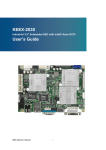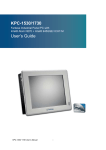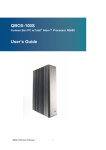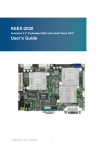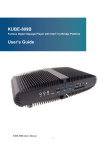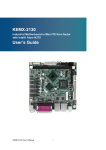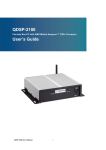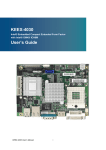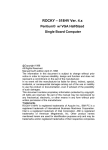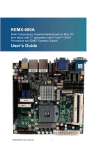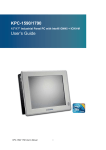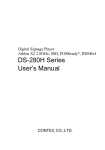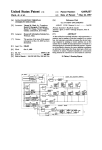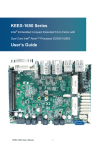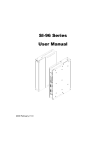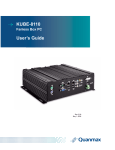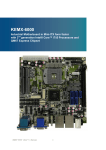Download KEMX-2031/2030 User Manual
Transcript
KEMX-2030 Industrial Motherboard in Mini-ITX form factor with Intel® Atom N270 User’s Guide KEMX-2030 User’s I Contact Info: Quanmax Inc. 4F, No. 415, Ti-Ding Blvd. Sec. 2NeiHu District, Taipei 114Taiwan Tel: +886-2-2799-2789 Fax: +886-2-2799-7399 Visit our site at: www.quanmax.com © 2008 Quanmax Inc. All rights reserved. The information in this user’s guide is provided for reference only. Quanmax does not assume any liability arising out of the application or use of the information or products described herein. This user’s guide may contain or reference information and products protected by copyrights or patents and does not convey any license under the patent rights of Quanmax, nor the rights of others. Quanmax is a registered trademark of Quanmax. All trademarks, registered trademarks, and trade names used in this user’s guide are the property of their respective owners. All rights reserved. This user’s guide contains information proprietary to Quanmax. Customers may reprint and use this user’s guide in other publications. Customers may alter this user’s guide and publish it only after they remove the Quanmax name, cover, and logo. Quanmax reserves the right to make changes without notice in product or component design as warranted by evolution in user needs or progress in engineering or manufacturing technology. Changes which affect the operation of the unit will be documented in the next revision of this user’s guide. Revision 1.0 1.01 1.02 1.03 1.04 Date 12/31/2008 2/16/2009 4/06/2009 7/27/2009 12/16/2009 Edited by SLee SLee SLee SLee SLee 1.05 06/29/2010 Zack 1.06 1.07 1.08 12/09/2010 01/29/2011 02/06/2012 Zack Zack Betsy KEMX-2030 User’s II Changes Initial Release Add LPT Add I/O Shield in packing list Add COM1 RS422/485 pin out Correct RS232/422/485 pin assignment Update DIO and Watchdog Timer Sample Code Update Table 9 pin definition Add Remark on clear CMOS Add Jumper (JP 10) Content Content Content....................................................................................................................... 3 Figures ....................................................................................................................... 5 Tables ......................................................................................................................... 6 Safety Instructions ...................................................................................................... 8 Before You Begin...................................................................................... 8 When Working Inside a Computer ............................................................ 8 Preventing Electrostatic Discharge ........................................................... 9 Preface ..................................................................................................................... 11 How to Use This Guide........................................................................... 11 Unpacking .............................................................................................. 11 Regulatory Compliance Statements ....................................................... 11 Warranty Policy ...................................................................................... 12 Maintaining Your Computer .................................................................... 13 Chapter 1 Introduction ........................................................................................... 16 Overview ................................................................................................ 16 Product Specifications ............................................................................ 17 System Block Diagram ........................................................................... 18 Mechanical Dimensions.......................................................................... 19 Chapter 2 Hardware Settings ................................................................................ 20 Overview ................................................................................................ 20 Jumper Settings and Pin Definitions....................................................... 21 Jumper Settings ......................................................................................... 22 Rear Panel Pin Assignments...................................................................... 24 Main Board Pin Assignments ..................................................................... 27 Chapter 3 System Installation ................................................................................ 37 Expansive Interfaces .............................................................................. 37 Memory Module Installation.................................................................... 37 Chapter 4 AMI BIOS Setup.................................................................................... 39 Overview ................................................................................................ 39 Main Menu.............................................................................................. 40 Advanced Menu ..................................................................................... 41 Boot Menu .............................................................................................. 45 Chipset Menu ......................................................................................... 46 Power Menu ........................................................................................... 48 KEMX-2030 User’s 3 Content Security Menu ................................................................................................... 49 Exit Menu ............................................................................................... 50 Chapter 5 Driver Installation .................................................................................. 52 Appendix A System Resources.............................................................................. 53 Appendix B DIO (Digital I/O) KIT User Guide ........................................................... 56 Appendix C DIO (Digital I/O) Sample Code.............................................................. 61 Appendix D WatchDog Timer Sample Code ............................................................ 63 KEMX-2030 User’s 4 Figures Figures Figure 1 Block Diagram ............................................................................. 18 Figure 2 Mechanical Dimensions ............................................................... 19 Figure 3 Jumper Connector ....................................................................... 20 Figure 4 Jumper and Connector Locations ................................................ 21 Figure 5 Rear Panel IO .............................................................................. 24 Figure 6 Expansive Interfaces.................................................................... 37 Figure 7 Align the SO-DIMM Memory Module with the onboard socket ..... 38 Figure 8 Press down on the SO-DIMM Memory Module to lock it in place 38 KEMX-2030 User’s 5 Tables Tables Table 1 KEMX-2030 Specification .............................................................. 17 Table 2 Jumper List .................................................................................... 22 Table 3 JP1 Backlight Enable Selection ..................................................... 22 Table 4 JP2 Backlight & Panel Power Selection ........................................ 22 Table 5 JP3 Clear CMOS Selection ......................................................... 22 Table 6 JP4 COM1 Signal / Power Selection ............................................. 23 Table 7 JP5/ 6/ 7 COM2/ 3/ 4 Signal / Power Selection ............................. 23 Table 8 JP8 For Quanmax internal test only, do not change default setting23 Table 9 JP9 Power Mode Selection ........................................................... 23 Table 10 JP10 VGA-Always-On Enable Disable Selection ........................ 23 Table 11 Rear Panel Connector List........................................................... 24 Table 12 AUDIO1, 3-Port Audio phone jack ............................................... 24 Table 13 USB2, USB2.0 Port 2, 3 Type A Connector ................................. 24 Table 14 CN9, USB2.0 Port 0, 1 Connector & Ethernet RJ-45 Connector . 25 Table 15 CN1, VGA Connector & RS-232(422/485) Port A DB-9 Connector25 Table 16 CN 10, PS/2 KB/MS Connector ................................................... 26 Table 17 J1, +12V Power Input Connector................................................. 26 Table 18 Internal Connector List ................................................................ 27 Table 19 CN2, Panel Backlight Wafer ........................................................ 27 Table 20 CN3, Digital Input / Output Pin Header ........................................ 28 Table 21 CN4, Front Panel Audio Pin Header ............................................ 28 Table 22 CN5, CD-In Connector ................................................................ 28 Table 23 CN6, S/PDIF Pin Header ............................................................. 28 Table 24 CN7, Audio AMP Right Output Wafer .......................................... 29 Table 25 CN8, Audio AMP Left Output Wafer ............................................. 29 Table 26 CN11, AT Power Output Wafer .................................................... 29 Table 27 FP1, Front Panel 1 Pin Header ................................................... 29 Table 28 FP2, Front Panel 2 Pin Header ................................................... 30 Table 29 LVDS1, LVDS Panel Connector................................................... 30 Table 30 IDE1, Primary 44-pin IDE Box Header ........................................ 31 Table 31 SATA1,2, SATA Connector .......................................................... 31 Table 32 USB3, USB2.0 Port 4, 5 Pin Header ........................................... 32 Table 33 USB4, USB2.0 Port 6, 7 Pin Header ........................................... 32 Table 34 COMx RS-232 Port-x Box Header(x = 2, 3, 4) ..................... 32 KEMX-2030 User’s 6 Tables Table 35 PCIE1 PCIE slots ...................................................................... 33 Table 36 MPCI1, Mini-PCI Socket .............................................................. 33 Table 37 PCI1, PCI slots ............................................................................ 35 Table 38 ATX1, +12V Power Input Connector ............................................ 36 Table 39 Parallel Port Wafer ...................................................................... 36 Table 40 BIOS Main Menu ......................................................................... 40 Table 40 IDE Device Setting Menu ............................................................ 40 Table 42 System Information...................................................................... 41 Table 43 Advanced Menu ........................................................................... 41 Table 44 Onboard I/O Configuration .......................................................... 42 Table 45 OnBoard Peripherals Configuration Settings .............................. 43 Table 46 Trusted Computing ...................................................................... 44 Table 47 Hardware Health Configuration ................................................... 44 Table 48 Boot Menu ................................................................................... 45 Table 49 Chipset Menu .............................................................................. 46 Table 50 Video Function Configuration ...................................................... 47 Table 51 Power Menu ................................................................................ 48 Table 52 Security Menu ............................................................................. 49 Table 53 Exit Menu .................................................................................... 50 KEMX-2030 User’s 7 Safety Instructions Safety Instructions Before You Begin Before handling the product, read the instructions and safety guidelines on the following pages to prevent damage to the product and to ensure your own personal safety. Refer to the “Advisories” section in the Preface for advisory conventions used in this user’s guide, including the distinction between Warnings, Cautions, Important Notes, and Notes. Always use caution when handling/operating a computer. Only qualified, experienced, authorized electronics service personnel should access the interior of a computer. The power supplies produce high voltages and energy hazards, which can cause bodily harm. Use extreme caution when installing or removing components. Refer to the installation instructions in this user’s guide for precautions and procedures. If you have any questions, please contact Quanmax Post-Sales Technical Support. WARNING High voltages are present inside the chassis when the unit’s power cord is plugged into an electrical outlet. Turn off system power, turn off the power supply, and then disconnect the power cord from its source before removing the chassis cover. Turning off the system power switch does not remove power to components. When Working Inside a Computer Before taking covers off a computer, perform the following steps: 1. Turn off the computer and any peripherals. 2. Disconnect the computer and peripherals from their power sources or subsystems to prevent electric shock or system board damage. This does not apply when hot swapping parts. KEMX-2030 User’s 8 Safety Instructions 3. 4. Follow the guidelines provided in “Preventing Electrostatic Discharge” on the following page. Disconnect any telephone or telecommunications lines from the computer. In addition, take note of these safety guidelines when appropriate: To help avoid possible damage to system boards, wait five seconds after turning off the computer before removing a component, removing a system board, or disconnecting a peripheral device from the computer. When you disconnect a cable, pull on its connector or on its strain-relief loop, not on the cable itself. Some cables have a connector with locking tabs. If you are disconnecting this type of cable, press in on the locking tabs before disconnecting the cable. As you pull connectors apart, keep them evenly aligned to avoid bending any connector pins. Also, before connecting a cable, make sure both connectors are correctly oriented and aligned. CAUTION Do not attempt to service the system yourself except as explained in this user’s guide. Follow installation and troubleshooting instructions closely. Preventing Electrostatic Discharge Static electricity can harm system boards. Perform service at an ESD workstation and follow proper ESD procedure to reduce the risk of damage to components. Quanmax strongly encourages you to follow proper ESD procedure, which can include wrist straps and smocks, when servicing equipment. You can also take the following steps to prevent damage from electrostatic discharge (ESD): When unpacking a static-sensitive component from its shipping carton, do not remove the component’s antistatic packing material until you are ready to install the component in a computer. Just before unwrapping the antistatic packaging, be sure you are at an ESD workstation or grounded. This will discharge any static electricity that may have built up in your body. When transporting a sensitive component, first place it in an antistatic container KEMX-2030 User’s 9 Safety Instructions or packaging. Handle all sensitive components at an ESD workstation. If possible, use antistatic floor pads and workbench pads. Handle components and boards with care. Don’t touch the components or contacts on a board. Hold a board by its edges or by its metal mounting bracket. Do not handle or store system boards near strong electrostatic, electromagnetic, magnetic, or radioactive fields. KEMX-2030 User’s 10 Preface Preface How to Use This Guide This guide is designed to be used as step-by-step instructions for installation, and as a reference for operation, troubleshooting, and upgrades. NOTE Driver downloads and additional information are available under Downloads on our web site: www.quanmax.com. Unpacking When unpacking, follow these steps: 1. After opening the box, save it and the packing material for possible future shipment. 2. Remove all items from the box. If any items listed on the purchase order are missing, notify Quanmax customer service immediately. 3. Inspect the product for damage. If there is damage, notify Quanmax customer service immediately. Refer to “Warranty Policy” for the return procedure. Regulatory Compliance Statements This section provides the FCC compliance statement for Class A devices. FCC Compliance Statement for Class A Devices The product(s) described in this user’s guide has been tested and found to comply with the limits for a Class A digital device, pursuant to Part 15 of the FCC Rules. These limits are designed to provide reasonable protection against harmful interference when the equipment is operated in a commercial environment. This equipment generates, uses, and can radiate radio frequency energy and, if not installed and used in accordance with the user’s guide, may cause harmful interference to radio communications. Operation of this equipment in a residential KEMX-2030 User’s 11 Preface area (domestic environment) is likely to cause harmful interference, in which case the user will be required to correct the interference (take adequate measures) at their own expense. Changes or modifications not expressly approved by Quanmax could void the user's authority to operate the equipment. NOTE The assembler of a personal computer system may be required to test the system and/or make necessary modifications if a system is found to cause harmful interference or to be noncompliant with the appropriate standards for its intended use. Warranty Policy Limited Warranty Quanmax Inc.’s detailed Limited Warranty policy can be found under Support at www.quanmax.com. Please consult your distributor for warranty verification. The limited warranty is void if the product has been subjected to alteration, neglect, misuse, or abuse; if any repairs have been attempted by anyone other than Quanmax or its authorized agent; or if the failure is caused by accident, acts of God, or other causes beyond the control of Quanmax or the manufacturer. Neglect, misuse, and abuse shall include any installation, operation, or maintenance of the product other than in accordance with the user’s guide. No agent, dealer, distributor, service company, or other party is authorized to change, modify, or extend the terms of this Limited Warranty in any manner whatsoever. Quanmax reserves the right to make changes or improvements in any product without incurring any obligation to similarly alter products previously purchased. Return Procedure For any Limited Warranty return, please contact Support at www.quanmax.com and login to obtain a Return Material Authorization (RMA) Number. If you do not have an account, send an email to [email protected] to apply for one. All product(s) returned to Quanmax for service or credit must be accompanied by a Return Material Authorization (RMA) Number. Freight on all returned items must be prepaid by the customer who is responsible for any loss or damage caused by common carrier in transit. Returns for Warranty must include a Failure Report for each unit, by serial number(s), as well as a copy of the original invoice showing the KEMX-2030 User’s 12 Preface date of purchase. To reduce risk of damage, returns of product must be in a Quanmax shipping container. If the original container has been lost or damaged, new shipping containers may be obtained from Quanmax Customer Service at a nominal cost. Quanmax owns all parts removed from repaired products. Quanmax uses new and reconditioned parts made by various manufacturers in performing warranty repairs and building replacement products. If Quanmax repairs or replaces a product, its warranty term is not extended. Shipments not in compliance with this Limited Warranty Return Policy will not be accepted by Quanmax. Limitation of Liability In no event shall Quanmax be liable for any defect in hardware, software, loss, or inadequacy of data of any kind, or for any direct, indirect, incidental, or consequential damages in connection with or arising out of the performance or use of any product furnished hereunder. Quanmax’s liability shall in no event exceed the purchase price of the product purchased hereunder. The foregoing limitation of liability shall be equally applicable to any service provided by Quanmax or its authorized agent. Maintaining Your Computer Environmental Factors Temperature The ambient temperature within an enclosure may be greater than room ambient temperature. Installation in an enclosure should be such that the amount of air flow required for safe operation is not compromised. Consideration should be given to the maximum rated ambient temperature. Overheating can cause a variety of problems, including premature aging and failure of chips or mechanical failure of devices. If the system has been exposed to abnormally cold temperatures, allow a two-hour warm-up period to bring it up to normal operating temperature before turning it on. Failure to do so may cause damage to internal components, particularly the hard disk drive. Humidity High-humidity can cause moisture to enter and accumulate in the system. This moisture can cause corrosion of internal components and degrade such KEMX-2030 User’s 13 Preface properties as electrical resistance and thermal conductivity. Extreme moisture buildup inside the system can result in electrical shorts, which can cause serious damage to the system. Buildings in which climate is controlled usually maintain an acceptable level of humidity for system equipment. However, if a system is located in an unusually humid location, a dehumidifier can be used to maintain the humidity within an acceptable range. Refer to the “Specifications” section of this user’s guide for the operating and storage humidity specifications. Altitude Operating a system at a high altitude (low pressure) reduces the efficiency of the cooling fans to cool the system. This can cause electrical problems related to arcing and corona effects. This condition can also cause sealed components with internal pressure, such as electrolytic capacitors, to fail or perform at reduced efficiency. Power Protection The greatest threats to a system’s supply of power are power loss, power spikes, and power surges caused by electrical storms, which interrupt system operation and/or damage system components. To protect your system, always properly ground power cables and one of the following devices. Surge Protector Surge protectors are available in a variety of types and usually provide a level of protection proportional with the cost of the device. Surge protectors prevent voltage spikes from entering a system through the AC power cord. Surge protectors, however, do not offer protection against brownouts, which occur when the voltage drops more than 20 percent below the normal AC line voltage level. Line Conditioner Line conditioners go beyond the over voltage protection of surge protectors. Line conditioners keep a system’s AC power source voltage at a fairly constant level and, therefore, can handle brownouts. Because of this added protection, line conditioners cost more than surge protectors. However, line conditioners cannot protect against a complete loss of power. Uninterruptible Power Supply KEMX-2030 User’s 14 Preface Uninterruptible power supply (UPS) systems offer the most complete protection against variations on power because they use battery power to keep the server running when AC power is lost. The battery is charged by the AC power while it is available, so when AC power is lost, the battery can provide power to the system for a limited amount of time, depending on the UPS system. UPS systems range in price from a few hundred dollars to several thousand dollars, with the more expensive unit s allowing you to run larger systems for a longer period of time when AC power is lost. UPS systems that provide only 5 minutes of battery power let you conduct an orderly shutdown of the system, but are not intended to provide continued operation. Surge protectors should be used with all UPS systems, and the UPS system should be Underwriters Laboratories (UL) safety approved. KEMX-2030 User’s 15 Chapter 1 Chapter 1 Introduction Overview The KEMX-2030 is a Mini-ITX form factor industrial motherboard combining the latest Intel 45nm Intel® Atom™ processor with the high integration of the Intel® 945GSE/ ICH7-M chipset. The new architecture of Atom™ N270 enable the lowest power consumption and smallest form factor for thin client and fundamental use. Featured are DDR2-400/533 SODIMM up to 2GB, 18/ 24-bit LVDS, Fast Ethernet, SATA 3 Gb/s, PCIe riser for 3x PCIe x1/ PCI/ mini PCI Expansion slot, 8x USB 2.0, 4 COM ports with Power Selection, HD audio, and keyboard/mouse. The KEMX-2030 is a compact, high performance industrial motherboard that is ideal for multimedia, gaming, mobile PC, and thin client applications. Checklist Driver/ Manual CD Quick Installation Guide I/O Shield KEMX-2030 Mini-ITX Embedded Board SATA cable (7-pin connector with lock, L=46cm) Features Intel® Atom™ Processor N270 Intel® 945GSE / ICH7-M Supports Dual Display, VGA,18/24-bit LVDS DDR2 SO-DIMM Socket, total up to 2 GB Mini PCI Socket, PCI slot, PCIe riser for 3x PCIe x1 2x SATA 3 Gb/s, 8x USB 2.0, 1x Fast Ethernet (Optional GbE) 4x COM ports, 4x DI/DO Watchdog Timer, Hardware Monitor, TPM 1.2 KEMX-2030 User’s 16 Chapter 1 Product Specifications KEMX-2030` CPU Support Intel® Atom™ N270 Chipset Intel® 945GSE + ICH7-M Memory 1x DDR2 400/533 SO-DIMM Socket, up to 2GB BIOS AMI PnP 8Mb SPI ROM Display Integrated on Intel® 945GSE Chipset 18/24-bit dual-channel LVDS from Chrontel CH7308 18-bit Dual channel LVDS from 945GSE optional 1x VGA LAN 1x RJ-45, Fast Ethernet (Realtek RTL8102E) or 1x RJ-45, Gigabit Ethernet (Realtek RTL8111C optional) Audio HD Audio Codec, supports Line-in, Line-out & Microphone (Realtek ALC883) Speak-out with AMP. 2x 2W 1x S/PDIF Peripheral Support 1x IDE (UltraDMA 100 / 66 / 33) 2x SATA 3Gb/s 4x COMs with Power Selection 8x USB 2.0 1x PS/2 Keyboard connector 1x PS/2 Mouse connector 1x Parallel port (Box Header) 4x DI/DO TPM TPM 1.2 Power Connector ATX-4P or DC Jack for 12V Power Input only Expansion 1x PCI slot, 1x Mini PCI 1x PCIe riser for 3x PCIe x1 Watchdog Timer 1-255 step, can be set with software on Super I/O Hardware Monitor Operating voltage, CPU temperature and fan speed Dimensions Mini-ITX (170 x 170 mm) Environmental Factors Operation Temp: 0ºC - 60ºC Storage Temp.: -10ºC - 85ºC Humidity: 0% - 90% Certifications CE, FCC Class A Table 1 KEMX-2030 Specification KEMX-2030 User’s 17 Chapter 1 System Block Diagram Figure 1 Block Diagram KEMX-2030 User’s 18 Chapter 1 Mechanical Dimensions Figure 2 Mechanical Dimensions KEMX-2030 User’s 19 Chapter 2 Chapter 2 Hardware Settings Overview This chapter provides the definitions and locations of jumpers, headers, and connectors. Jumpers The product has several jumpers which must be properly configured to ensure correct operation. Figure 3 Jumper Connector For a three-pin jumper (see Figure 3), the jumper setting is designated “1-2” when the jumper connects pins 1 and 2. The jumper setting is designated “2-3” when pins 2 and 3 are connected and so on. You will see that one of the lines surrounding a jumper pin is thick, which indicates pin No.1. To move a jumper from one position to another, use needle-nose pliers or tweezers to pull the pin cap off the pins and move it to the desired position. KEMX-2030 User’s 20 Chapter 2 Jumper Settings and Pin Definitions For jumper and connector locations, please refer to the diagrams below. Figure 4 Jumper and Connector Locations KEMX-2030 User’s 21 Chapter 2 Jumper Settings To ensure correct system configuration, the following section describes how to set the jumpers to enable/disable or change functions. For jumper descriptions, please refer to the table below. Label JP1 JP2 JP3 JP4 JP5 JP6 JP7 JP8 JP9 JP10 Table 2 Jumper List Function Backlight Enable Selection Backlight & Panel Power Selection Clear CMOS Selection COM1 Signal / Power Selection COM2 Signal / Power Selection COM3 Signal / Power Selection COM4 Signal / Power Selection For Quanmax internal test only Power Mode Selection VGA-Always-On Enable Disable Selection Table 3 JP1 Backlight Enable Selection Jumper Status 1-2 Active High (Default) 2-3 Active Low Pitch:2.0mm [YIMTEX 3291*03SAGR(6T)] Table 4 JP2 Backlight & Panel Power Selection Jumper 1 2 Setting Status 1-3 Backlight Power = +12V (Default) 3-5 Backlight Power = +5V 2-4 Panel Power = +3.3V (Default) 4-6 Panel Power = +5V Pitch 2.54mm [YIMTEX 3362*03SAGR] Table 5 JP3 Clear CMOS Selection Jumper Status Open Normal Operation (Default) Short Clear CMOS Pitch:2.54mm [YIMTEX 3321*02SAGR(6T)] Remark: You must go to BIOS EXIT menu to do “Load Optimal Defaults” after clear CMOS. Please refer to table 52. KEMX-2030 User’s 22 Chapter 2 Table 6 JP4 COM1 Signal / Power Selection Jumper Setting Function 1-3 Short Pin 1 of COM1 = +12V 3-5 Short Pin 1 of COM1 = +5V 1 5-7 Short Pin 1 of COM1 = +5V Pin 1 of COM1 = DCD@RS232, 7-9 Short TX-@RS422, DATA-@RS485 (Default) 2-4 Short Pin 9 of COM1 = +12V 4-6 Short Pin 9 of COM1 = +5V 2 6-8 Short Pin 9 of COM1 = +5V 8-10 Short Pin 9 of COM1 = RI (Default) Pitch: 2.54mm [YIMTEX 3322*05SAGR(6T] Table 7 JP5/ 6/ 7 COM2/ 3/ 4 Signal / Power Selection Jumper Setting Function 1-3 Short Pin 1 of COM2/ 3/ 4 = +12V 3-5 Short Pin 1 of COM2/ 3/ 4 = +5V 1 5-7 Short Pin 1 of COM2/ 3/ 4 = +5V 7-9 Short Pin 1 of COM2/ 3/ 4 = DCD (Default) 2-4 Short Pin 9 of COM2/ 3/ 4 = +12V 4-6 Short Pin 9 of COM2/ 3/ 4 = +5V 2 6-8 Short Pin 9 of COM2/ 3/ 4 = +5V 8-10 Short Pin 9 of COM2/ 3/ 4 = RI (Default) Pitch:2.54mm [YIMTEX 3322*05SAGR(6T] Table 8 JP8 For Quanmax internal test only, do not change default setting Jumper Status 1-2 Normal (Default) 2-3 Debug Mode Pitch: 2.0mm [YIMTEX 3291*03SAGR(6T)] Table 9 JP9 Power Mode Selection Jumper Status Open ATX Mode (Default) Short AT Mode Pitch: 2.54mm [YIMTEX 3321*02SAGR(6T)] Table 10 JP10 VGA-Always-On Enable Disable Selection Jumper Status 1 Open Enable 2 Short Disable Pitch:2.54mm [YIMTEX 3321*02SAGR(6T)] KEMX-2030 User’s 23 Chapter 2 Rear Panel Pin Assignments Figure 5 Rear Panel IO Table 11 Rear Panel Connector List Label Function AUDIO1 3-Port Audio phone jack USB2 USB2.0 Port 2 , 3 Type A Connector CN9 USB2.0 Port 0, 1 Type A Connector & 10/100 Ethernet RJ-45 Connector CN1 VGA Connector & RS-232(422/485) Port A DB-9 Connector CN10 PS/2 KB/MS Connector J1 +12V Power Input Connector Table 12 AUDIO1, 3-Port Audio phone jack Signal Name BLUE LINE IN GREEN LINE OUT PINK MIC IN AUDIO JACK*3 DIP Vertical [Foxconn JA33331-H11P-4F] Table 13 USB2, USB2.0 Port 2, 3 Type A Connector Pin Signal Name Pin Signal Name 1 +5V 5 +5V 2 USB1- 6 USB0- 3 USB1+ 7 USB0+ 4 GND 8 GND USB DIP 4*2P 90D [KUON YI KS-002-ANB-L] KEMX-2030 User’s 24 Chapter 2 Table 14 CN9, USB2.0 Port 0, 1 Connector & Ethernet RJ-45 Connector Pin Signal Pin Signal 1 MDI[0]+ U1 +5V 2 MDI[0]- U2 USB0- 3 MDI[1]+ U3 USB0+ 4 MDI[1]- U4 GND 5 MDI[2]+ U5 +5V 6 MDI[2]- U6 USB1- 7 MDI[3]+ U7 USB1+ 8 MDI[3]- U8 GND USB*2/RJ45*1+TFM+LED(10/100)22P DIP 90° [UDE RU1-161A1Z1F(XB)] Table 15 CN1, VGA Connector & RS-232(422/485) Port A DB-9 Connector Pin 1 2 3 4 5 6 7 8 9 RS422 (COM1*) RS232 DCD, Data carrier detect TXRXD, Receive data RX+ TXD, Transmit data TX+ DTR, Data terminal ready RXGND, ground DSR, Data set ready RTS, Request to send CTS, Clear to send RI, Ring indicator RS485 Half Duplex (COM1*) DATAN/A DATA+ N/A Signal Name Pin Pin Signal Name Red 1 2 Green Blue 3 4 NC GND 5 6 GND GND 7 8 GND VCC 9 10 GND NC 11 12 DDC2B data HSYNC 13 14 VSYNC DDC2B clock 15 D-SUB 9P(M)&15S(19.05mm(F) FOR PC99 FOLLOW PANTONE COLOR[ D201B1N01002N] KEMX-2030 User’s 25 Chapter 2 Table 16 CN 10, PS/2 KB/MS Connector Pin Signal Function 1 KBDAT Keyboard Data 2 NC No Connect 3 GND Ground 4 KB5V +5VSB Power Source 5 KBCLK Keyboard Clock 6 NC No Connect 7 MSDAT Mouse Data 8 NC No Connect 9 GND Ground 10 KB5V +5VSB Power Source 11 MSCLK Mouse Clock 12 NC No Connect MINI DIN DIP 6/6P MH11061-P36-4F 90D(F) Kb/Ms for PC99 CONNECTOR [FOXCONN] Table 17 J1, +12V Power Input Connector Pin Signal 1 NC 2 +12V 3 GND DC POWER DIP 3PIN φ 2.5mm 90° [KUON YI KD-014SA-L] NOTE Do not use J1 & ATX1 connectors at the same time. KEMX-2030 User’s 26 Chapter 2 Main Board Pin Assignments Label CN2 CN3 CN4 CN5 CN6 CN7 CN8 CN11 DIMM1 FP1 FP2 LVDS1 IDE1 SATA1 SATA2 USB3 USB4 COM2 COM3 COM4 PCIE1 MPCI1 PCI1 ATX1 LPT1 Table 18 Internal Connector List Function Panel Backlight Wafer Digital Input / Output Pin Header Front Panel Audio Pin Header CD-In Connector Pin Header S/PDIF Pin Header Audio AMP Right Output Wafer Audio AMP Left Output Wafer AT Power Wafer DDR2 Memory SO-DIMM Socket Front Panel 1 Pin Header Front Panel 2 Pin Header LVDS Panel Pin Header 44PIN 2.0mm Pin Header Serial ATA Connector Serial ATA Connector USB2.0 Port 4, 5 Pin Header USB2.0 Port 6, 7 Pin Header RS-232 Port 2 With Power Wafer RS-232 Port 3 With Power Wafer RS-232 Port 4 With Power Wafer PCIE slots Mini PCI slots PCI slots +12V Power Input Connector Parallel Port Wafer Table 19 CN2, Panel Backlight Wafer Pin Signal Name 7 NC 6 BL_ADJ 5 GND 4 +5V / +12V * 3 +5V / +12V * 2 GND 1 BL_EN / BL_EN# * *:Selected by JP2 **:Selected by JP1 Pitch:1.25mm WAFER [YIMTEX 501MW1*7STR] KEMX-2030 User’s 27 Chapter 2 Table 20 CN3, Digital Input / Output Pin Header Pin Signal Pin Signal 1 Digital Output 0 2 Digital Input 0 3 Digital Output 1 4 Digital Input 1 5 Digital Output 2 6 Digital Input 2 7 Digital Output 3 8 Digital Input 3 9 +5V 10 GND Pitch:2.54mm [YIMTEX 3322*05SAGR(6T] Table 21 CN4, Front Panel Audio Pin Header Pin Signal Pin Signal 1 MIC2-L 2 Audio GND 3 MIC2-R 4 ACZ_DET# 5 Line2-R 6 MIC2_JD 7 FIO_Sense 8 Key 9 Line2-L 10 Line2_JD Pitch:2.54mm w/o Pin 8 [YIMTEX 3322*05SAGR(6T)-08] Table 22 CN5, CD-In Connector Pin Signal Name 1 CD-IN-R 2 GND 3 GND 4 CD-IN-L Pitch:2.54mm WAFER [YIMTEX 522CW4SGR] Table 23 CN6, S/PDIF Pin Header Pin Signal Name 1 S/PDIF In 2 GND 3 S/PDIF Out 4 GND Pitch:2.54mm [YIMTEX 3321*04SAGR(6T)] KEMX-2030 User’s 28 Chapter 2 Table 24 CN7, Audio AMP Right Output Wafer Pin Signal Name 1 Speaker+ 2 Speaker- Pitch=2.0mm WAFER [YIMTEX 503PW1*02STR] Table 25 CN8, Audio AMP Left Output Wafer Pin Signal Name 1 Speaker+ 2 Speaker- Pitch=2.0mm WAFER [YIMTEX 503PW1*02STR] Table 26 CN11, AT Power Output Wafer Pin Signal Name 1 +12V 2 GND 3 GND 4 +5V Pitch: 5.08mm W/O LOCK [VENSIK 2470-F-04PST-PB] Table 27 FP1, Front Panel 1 Pin Header Pin Signal Pin Signal 1 Reset Button + 2 Speaker + 3 Reset Button - 4 NC 5 HDD LED + 6 NC 7 HDD LED - 8 Speaker - Pins 2, 8: External Speaker wire Pins 6-8 shorted: Internal Speaker Enable (default) Pitch:2.54mm [YIMTEX 3322*04SAGR(6T)] KEMX-2030 User’s 29 Chapter 2 Table 28 FP2, Front Panel 2 Pin Header Pin Signal Pin Signal 1 Power LED + 2 Power Button + 3 NC 4 Power Button - 5 Power LED - 6 NC 7 Keyboard Lock 8 SMBus Data 9 GND 10 SMBus Clock Pitch:2.54mm [YIMTEX 3322*05SAGR(6T] Table 29 LVDS1, LVDS Panel Connector Pin Signal Name Pin Signal Name 1 NC 2 NC 3 LVDS_A0- 4 LVDS_A0+ 5 LVDS_A1- 6 LVDS_A1+ 7 LVDS_A2- 8 LVDS_A2+ 9 LVDS_ACK- 10 LVDS_ACK+ 11 LVDS_A3- 12 LVDS_A3+ 13 GND 14 GND 15 LVDS_B0- 16 LVDS_B0+ 17 LVDS_B1- 18 LVDS_B1+ 19 LVDS_B2- 20 LVDS_B2+ 21 LVDS_BCK- 22 LVDS_BCK+ 23 LVDS_B3- 24 LVDS_B3+ 25 NC 26 GND 27 NC 28 +3.3V / +5V * 29 +3.3V / +5V * 30 +3.3V / +5V * *:Selected by JP2 Pitch:2.0mm CUT27 [YIMTEX 3292*15SAGR(6T)-27] KEMX-2030 User’s 30 Chapter 2 Table 30 IDE1, Primary 44-pin IDE Box Header Signal Name Pin Pin Signal Name Reset IDE 1 2 GND IDE Data 7 3 4 IDE Data 8 IDE Data 6 5 6 IDE Data 9 IDE Data 5 7 8 IDE Data 10 IDE Data 4 9 10 IDE Data 11 IDE Data 3 11 12 IDE Data 12 IDE Data 2 13 14 IDE Data 13 IDE Data 1 15 16 IDE Data 14 IDE Data 0 17 18 IDE Data 15 Ground 19 20 NC DREQ0 21 22 GND IDEIOW# 23 24 GND IDEIOR# 25 26 GND IDEIORDY 27 28 CBSEL DACK0# 29 30 GND IDEIRQ14 31 32 NC IDE Address 1 33 34 PDIAG# IDE Address 0 35 36 IDE Address 2 IDE Chip select 1# 37 38 IDE Chip select 3# IDE activity 39 40 GND +5V 41 42 +5V GND 43 44 NC Pitch:2.0mm [YIMTEX 32644SAGR(6T)] Table 31 SATA1,2, SATA Connector Pin Signal Name 1 GND 2 TX+ 3 TX- 4 GND 5 RX- 6 RX+ 7 GND SATA WATM-07ABN4B2B8UW4 [WIN WIN] KEMX-2030 User’s 31 Chapter 2 Table 32 USB3, USB2.0 Port 4, 5 Pin Header Pin Signal Name Pin Signal Name 1 +5V 2 +5V 3 USB4- 4 USB5- 5 USB4+ 6 USB5+ 7 GND 8 GND 9 KEY 10 GND Pitch:2.54mm [YIMTEX 3322*05SAGR(6T) -09] Table 33 USB4, USB2.0 Port 6, 7 Pin Header Pin Signal Name Pin Signal Name 1 +5V 2 +5V 3 USB6- 4 USB7- 5 USB6+ 6 USB7+ 7 GND 8 GND 9 KEY 10 GND Pitch:2.54mm [YIMTEX 3322*05SAGR(6T) -09] Table 34 COMx RS-232 Port-x Box Header(x = 2, 3, 4) Pin Signal 1 +5V / +12V / DCD, Data carrier detect Note:Selected by JPx 2 RXD, Receive data 4 DTR, Data terminal ready 5 GND, ground 3 TXD, Transmit data 6 DSR, Data set ready 7 RTS, Request to send 8 CTS, Clear to send 9 +5V / +12V / RI, Ring indicator Note:Selected by JPx 10 NC Pitch:2.54mm [YIMTEX 32510SAG1R(6T)] KEMX-2030 User’s 32 Chapter 2 Table 35 PCIE1 PCIE slots PCIE slots Pin Side B Side A 1 12V 3.3V 2 12V 3.3V 3 3.3VSB Ground 4 PCIE_WAKE# CLK100_PCIE+ 5 PCI_RST# CLK100_PCIE- 6 Ground Ground 7 PCIE_TXP2 PCIE_RXP2 8 PCIE_TXN2 PCIE_RXN2 9 Ground Ground 10 PCIE_TXP3 PCIE_RXP3 11 PCIE_TXN3 PCIE_RXN3 12 Ground Ground 13 Ground Ground 14 NC NC 15 NC NC 16 Ground Ground 17 NC NC 18 NC NC PCI 18*2P EXPRESS 180D(F) Black [ Win Win WPES--036AN41B22UWS] Table 36 MPCI1, Mini-PCI Socket Pin Signal 1 NC 3 NC 5 NC 7 NC 9 NC 11 NC 13 NC 15 GND 17 INTA# 19 +3.3V 21 NC 23 GND 25 PCICLK 27 GND 29 REQ# 31 +3.3V KEMX-2030 User’s 33 Pin 2 4 6 8 10 12 14 16 18 20 22 24 26 28 30 32 Signal NC NC NC NC NC NC NC NC +5V INTD# NC +3.3V_SB RST# +3.3V GNT# GND Chapter 2 33 35 37 39 41 43 45 47 49 51 53 55 57 59 61 63 65 67 69 71 73 75 77 79 81 83 85 87 89 91 93 95 97 99 101 103 105 107 109 111 113 115 117 119 121 123 AD31 AD29 GND AD27 AD25 NC CBE3# AD23 GND AD21 AD19 GND AD17 CBE2# IRDY# +3.3V NC SERR# GND PERR# CBE1# AD14 GND AD12 AD10 GND AD8 AD7 +3.3V AD5 NC AD3 +5V AD1 GND NC NC NC NC NC NC NC NC NC NC +5V 34 36 38 40 42 44 46 48 50 52 54 56 58 60 62 64 66 68 70 72 74 76 78 80 82 84 86 88 90 92 94 96 98 100 102 104 106 108 110 112 114 116 118 120 122 124 MINIPCI [FOXCONN AS0B126-S99N-4F] KEMX-2030 User’s 34 PME# NC AD30 +3.3V AD28 AD26 AD24 IDSEL GND AD22 AD20 PAR AD18 AD16 GND FRAME# TRDY# STOP# +3.3V DEVSEL# GND AD15 AD13 AD11 GND AD9 CBE0# +3.3V AD6 AD4 AD2 AD0 NC NC GND GND NC NC NC NC GND NC NC NC NC +3.3V Chapter 2 Table 37 PCI1, PCI slots 5V Board PCI Revision 2.1 Pin Side B Side A 1 -12V TRST_L 2 TCK +12V 3 Ground TMS 4 TDO TDI 5 +5V +5V 6 +5V INTA_L 7 INTB_L INTC_L 8 INTD_L +5V 9 PRSNT1_L Reserved 10 Reserved +5V 11 PRSNT2_L Reserved 12 Ground Ground 13 Ground Ground 14 Reserved Reserved 15 Ground RST_L 16 CLK +5V 17 Ground GNT_L 18 REQ_L Ground 19 +5V Reserved 20 AD[31] AD[30] 21 AD[29] +3.3V 22 Ground AD[28] 23 AD[27] AD[26] 24 AD[25] Ground 25 +3.3V AD[24] +3.3V 26 C/BE[3]_L IDSEL 27 AD[23] +3.3V 28 Ground AD[22] 29 AD[21] AD[20] 30 AD[19] Ground 31 +3.3V AD[18] 32 AD[17] AD[16] 33 C/BE[2]_L +3.3V 34 Ground FRAME_L 35 IRDY_L Ground 36 +3.3V TRDY_L 37 DEVSEL_L Ground 38 Ground STOP_L 39 LOCK_L +3.3V 40 PERR_L Reserved 41 +3.3V Reserved 42 SERR_L Ground 43 +3.3V PAR 44 C/BE[1]_L AD[15] 45 AD[14] +3.3V 46 Ground AD[13] 47 AD[12] AD[11] 48 AD[10] Ground 49 Ground AD[09] KEMX-2030 User’s 35 Comments 32-bit start 3.3V key 3.3V key Chapter 2 5V Board PCI Revision 2.1 Pin Side B Side A 50 KEYWAY KEYWAY 51 KEYWAY KEYWAY 52 AD[08] C/BE[0]_L 53 AD[07] +3.3V 54 +3.3V AD[06] 55 AD[05] AD[04] 56 AD[03] Ground 57 Ground AD[02] 58 AD[01] AD[00] 59 +5V +5V 60 ACK64_L REQ64_L 61 +5V +5V 62 +5V +5V Comments 5V key 5V key 32-bit end PCI 60*2P 180D (F) [FOXCONN EH06001-DAW-DF] Table 38 ATX1, +12V Power Input Connector Pin Signal Name 1 GND 2 GND 3 +12V 4 +12V Pitch:4.2mm [YIMTEX 576MWA2*02STR] NOTE Do not use J1 & ATX1 connectors at the same time. Table 39 Parallel Port Wafer Pin 1 3 5 7 9 11 13 15 17 19 21 23 25 Signal Name STB PD0 PD1 PD2 PD3 PD4 PD5 PD6 PD7 #ACK BUSY PE SLCT Pin 2 4 6 8 10 12 14 16 18 20 22 24 26 Signal Name #AFD #ERR #INIT #SLIN GND GND GND GND GND GND GND GND GND Pitch:2.54mm [YIMTEX 32526SAG1R(6T)] KEMX-2030 User’s 36 Chapter 3 Chapter 3 System Installation Expansive Interfaces The board comes with one PCIex1 slot , one PCI slot and one Mini-PCI interface. 1x PCIe riser for 3x PCIe x1 32-bit, 33MHz PCI slot 32-bit, 33MHz Mini-PCI socket Figure 6 Expansive Interfaces NOTE When adding or removing expansion cards, make sure that you unplug the power supply first. Meanwhile, read the documentation for the expansion card to configure any necessary hardware or software settings for the expansion card, such as jumpers, switches or BIOS configuration. Memory Module Installation Carefully follow the steps below in order to install the DIMMs: 1. 2. To avoid generating static electricity and damaging the SO-DIMM, ground yourself by touching a grounded metal surface or use a ground strap before you touch the SO-DIMM. Do not touch the connectors of the SO-DIMM. Dirt or other residue may cause a malfunction. KEMX-2030 User’s 37 Chapter 3 3. 4. To make sure the correct DDR2 SO-DIMM notches should match with the DDR2 SO-DIMM. Hold the SO-DIMM with its notch aligned with the memory socket of the board and insert it at a 30-degree angle into the socket. Figure 7 Align the SO-DIMM Memory Module with the onboard socket 5. 6. Fully insert the module into the socket until a “click” is heard. Press down on the SO-DIMM so that the tabs of the socket lock on both sides of the module Figure 8 Press down on the SO-DIMM Memory Module to lock it in place Removing a DIMM: To remove the SO-DIMM, use your fingers or a small screwdriver to carefully push away the tabs that secure either side of the SO-DIMM. Lift it out of the socket. Make sure you store the SO-DIMM in an anti-static bag. The socket must be populated with memory modules of the same size and manufacturer. KEMX-2030 User’s 38 Chapter 4 Chapter 4 AMI BIOS Setup Overview This chapter provides a description of the AMI BIOS. The BIOS setup menus and available selections may vary from those of your product. For specific information on the BIOS for your product, please contact Quanmax. NOTE: The BIOS menus and selections for your product may vary from those in this chapter. For the BIOS manual specific to your product, please contact Quanmax AMI's ROM BIOS provides a built-in Setup program, which allows the user to modify the basic system configuration and hardware parameters. The modified data will be stored in a battery-backed CMOS, so that data will be retained even when the power is turned off. In general, the information saved in the CMOS RAM will not need to be changed unless there is a configuration change in the system, such as a hard drive replacement or when a device is added. It is possible for the CMOS battery to fail, which will cause data loss in the CMOS only. If this happens you will need to reconfigure your BIOS settings. KEMX-2030 User’s 39 Chapter 4 Main Menu The BIOS Setup is accessed by pressing the DEL key after the Power-On Self-Test (POST) memory test begins and before the operating system boot begins. Once you enter the BIOS Setup Utility, the Main Menu will appear on the screen. The Main Menu provides System Overview information and allows you to set the System Time and Date. Use the “<” and “>” cursor keys to navigate between menu screens. Table 40 BIOS Main Menu BIOS SETUP UTILITY Main Advanced Boot Chipset System Date System Time Power [Wed 11/05/2008] [10:18:15] > Primary IDE Master > Primary IDE Slave > Secondary IDE Master > Secondary IDE Slave :[Not Detected] :[Not Detected] :[Not Detected] :[Not Detected] Security Exit Use [ENTER], [TAB] or [SHIFT-TAB] to select a field. Use [+] or [-] to configure system Time. > System Information <> Select Screen ↑↓ Select Item +- Change Field Tab Select Field F1 General Help F10 Save and Exit ESC Exit V02.61 (C)Copyright 1985-2006, American Megatrends, Inc. Below table is described for Primary IDE Master, Primary IDE Slave, Secondary IDE Master, and Secondary IDE Slave setting. Table 41 IDE Device Setting Menu BIOS SETUP UTILITY Main Advanced Primary Master Device LBA/ Large Mode DMA Mode S.M.A.R.T Boot Chipset Power Security Disable: Disables LBA Mode. Auto: Enables LBA Mode if the device supports it and the device is not already formatted with LBA Mode disabled. :Not Detected [Auto] [Auto] [Auto] <> Select Screen ↑↓ Select Item +- Change Field Tab Select Field F1 General Help F10 Save and Exit ESC Exit V02.61 (C)Copyright 1985-2006, American Megatrends, Inc. KEMX-2030 User’s Exit 40 Chapter 4 LBA/ Large Mode Enables or disables the LBA (Logical Block Addressing)/ Large mode. Setting to Auto enables the LBA mode if the device supports this mode, and if the device was not previously formatted with LBA mode disabled. Options: Disabled, Auto DMA Mode Options: Auto S.M.A.R.T SMART stands for Smart Monitoring, Analysis, and Reporting Technology. It allows AMIBIOS to use the SMART protocol to report server system information over a network. Options: Auto, Disabled, Enabled Table 42 System Information BIOS SETUP UTILITY Main Advanced AMIBIOS Version Build Date: Boot Chipset Power Security Exit : 1.3 :12/26/08 Processor Intel® Atom™ CPU N270 @ 1.60GHz Speed :1600MHz Count :1 <> Select Screen ↑↓ Select Item +- Change Field Tab Select Field F1 General Help F10 Save and Exit ESC Exit System Memory Size :1016MB V02.61 (C)Copyright 1985-2006, American Megatrends, Inc. Advanced Menu Table 43 Advanced Menu BIOS SETUP UTILITY Main Ad v a n c e d Boot Chipset Power Security Advanced Settings Warning: Setting wrong values in below sections may cause system to malfunction. <> Select Screen ↑↓ Select Item +- Change Field Tab Select Field F1 General Help F10 Save and Exit ESC Exit > I/O Configuration > OnBoard Peripherals Configuration > Trusted Computing > Hardware Health Configuration V02.61 (C)Copyright 1985-2006, American Megatrends, Inc. Press <Enter> to select a sub-menu for detailed options. KEMX-2030 User’s 41 Exit Chapter 4 Table 44 Onboard I/O Configuration BIOS SETUP UTILITY Main Ad v a n c e d Boot Onboard I/O Configuration COM1 Address COM1 IRQ COM1 Function Type COM2 Address COM2 IRQ COM3 Address COM3 IRQ COM3 Mode COM4 Address COM4 IRQ COM4 Mode Parallel Port Address Parallel Port Mode Parallel Port IRQ Chipset Power Security [3F8] [4] [RS232] [2F8] [4] [3E8] [10] [Normal] [2E8] [11] [Normal] [378] [Normal] [IRQ7] <> Select Screen ↑↓ Select Item +- Change Field Tab Select Field F1 General Help F10 Save and Exit ESC Exit V02.61 (C)Copyright 1985-2006, American Megatrends, Inc. COM1 Address Options: Disabled, 3F8, 3E8, 2E8 COM1 IRQ Options: 3, 4, 10, 11 COM1 Function Type Options: RS232, RS422, RS485 COM2 Address Options: Disabled, 2F8, 3E8, 2E8 COM2 IRQ Options: 3, 4, 10, 11 COM3 Address Options: Disabled, 3F8, 2F8, 3E8, 2E8, 2F0, 2E0 COM3 IRQ Options: 3, 4, 10, 11 COM3 Mode Options: Normal, IrDA, ASK IR, Smart Card Reader COM4 Address Options: Disabled, 3F8, 2F8, 3E8, 2E8, 2F0, 2E0 COM4 IRQ Options: 3, 4, 10, 11 COM4 Mode Options: Normal, IrDA, ASK IR, Smart Card Reader Parallel Port Address Options: 378, 278, 3BC Parallel Port Mode KEMX-2030 User’s Exit Allow BIOS to Select Serial Port1 Base Address. 42 Chapter 4 Options: Normal, EPP, ECP, EPP+ECP Parallel Port IRQ Options: IRQ5, IRQ7 Table 45 OnBoard Peripherals Configuration Settings BIOS SETUP UTILITY Main Ad v a n c e d Boot OnBoard Peripherals Configuration Settings USB Controller USB Device Legacy Support Audio Controller Onboard LAN Controller Onboard LAN OPTROM Chipset Power Security Options [Enable] [Enable] [Enable] [Enable] [Disabled] Disabled Enabled <> Select Screen ↑↓ Select Item +- Change Field Tab Select Field F1 General Help F10 Save and Exit ESC Exit V02.61 (C)Copyright 1985-2006, American Megatrends, Inc. USB Controller Options: Enabled, Disabled USB Device Legacy Support Options: Enabled, Disabled, Auto Audio Controller Options: Enabled, Disabled Onboard LAN Controller Options: Enabled, Disabled Onboard LAN OPTROM Options: Enabled, Disabled KEMX-2030 User’s 43 Exit Chapter 4 Table 46 Trusted Computing BIOS SETUP UTILITY Main Ad v a n c e d Boot Trusted Computing TCG/TPM SUPPORT Chipset Power Security Exit Enable/ Disable TPM TCG (TPM 1.1/1.2) supp in BIOS [NO] <> Select Screen ↑↓ Select Item +- Change Field Tab Select Field F1 General Help F10 Save and Exit ESC Exit V02.61 (C)Copyright 1985-2006, American Megatrends, Inc. TCG/TPM SUPPORT Options: No, Yes Table 47 Hardware Health Configuration BIOS SETUP UTILITY Main Ad v a n c e d Hardware Health Configuration CPU Warning Temperature CPU Shutdown Temperature Temperature Sensor #1 Temperature Sensor #1 +VCORE +1.05V +3.3V +5V +12V +1.8v +VCC RTC Boot Chipset Power Security [Disabled] [Disabled] :57°C/ 134°F :43°C/ 109°F :1.136 V :1.040 V :3.166 V :4.958 V :11.182 V :1.758 V :3.365 V <> Select Screen ↑↓ Select Item +- Change Field Tab Select Field F1 General Help F10 Save and Exit ESC Exit V02.61 (C)Copyright 1985-2006, American Megatrends, Inc. CPU Warning Temperature Options: Disabled, 80°C/176°F, 85°C/185°F, 90°C/194°F, 95°C/203°F CPU Shutdown Temperature Options: Disabled, 80°C/176°F, 85°C/185°F, 90°C/194°F, 95°C/203°F KEMX-2030 User’s 44 Exit Chapter 4 Boot Menu Table 48 Boot Menu BIOS SETUP UTILITY Main Advanced Boot Chipset Power Boot Settings Quick Boot Bootup Num-Lock Wait For ’F1’ If Error Hit ’DEL’Message Display [Enabled] [ON] [Enabled] [Enabled] Security Exit Allow BIOS to Skip certain tests while booting. This will decrease the time needed to boot the system. <> Select Screen ↑↓ Select Item +- Change Field Tab Select Field F1 General Help F10 Save and Exit ESC Exit V02.61 (C)Copyright 1985-2006, American Megatrends, Inc. Quick Boot Enabling this item allows BIOS to skip some Power On Self Tests (POST) while booting to decrease the time needed to boot the system. When set to [Disabled], BIOS performs all the POST items. Options: Disabled, Enabled Bootup Num-Lock [On] Allow you to select the power-on state for the NumLock. Options: Off, On Wait for ‘F1’ If Error [Enabled] When set to Enabled, the system waits for F1 key to be pressed when error occurs. Options: Disabled, Enabled Hit ‘DEL’ Message Display [Enabled] When set to Enabled, the system displays the message ‘Press DEL to run Setup’ during POST. Options: Disabled, Enabled KEMX-2030 User’s 45 Chapter 4 Chipset Menu Table 49 Chipset Menu BIOS SETUP UTILITY Main Advanced Boot Chipset Power Security Exit Options Chipset Settings DRAM Frequency [Auto] Boots Graphic Adapter Priority Internal Graphics Mode Select Hyper Threading Technology [PEG/PCI] [Enabled, 8MB] [Enabled] > Video Function Configuration Auto 400 MHz 533 MHz <> Select Screen ↑↓ Select Item +- Change Field Tab Select Field F1 General Help F10 Save and Exit ESC Exit V02.61 (C)Copyright 1985-2006, American Megatrends, Inc. DRAM Frequency Options: Auto, 400 MHz, 533MHz Boots Graphic Adapter Priority Select which graphics controller to use as the primary boot device. Options: IGD, PCI/IGD, PCI/PEG, PEG/IGD, PEG/PCI Internal Graphics Mode Select Select the amount of system memory used by the Internal graphics device. Options: Disabled, Enabled 1MB, Enabled 8M Hyper Threading Technology Options: Disabled, Enabled KEMX-2030 User’s 46 Chapter 4 Video Function Configuration Table 50 Video Function Configuration BIOS SETUP UTILITY Main Advanced Boot Chipset Video Function Configuration DVMT Mode Select DVMT/FIXED Memory Boot Display Device Flat Panel Type Local Flat Panel Scaling Panel BackLight Voltage Power Security Options [DVMT Mode] [128M] [VGA] [1024X768 [Auto] [2.5] Fixed Mode DVMT Mode Combo Mode 24Bit 1C] <> Select Screen ↑↓ Select Item +- Change Field Tab Select Field F1 General Help F10 Save and Exit ESC Exit V02.61 (C)Copyright 1985-2006, American Megatrends, Inc. DVMT Mode Select Options: Fixed Mode, DVMT Mode, Combo Mode DVMT/FIXED Memory Options: 64MB, 128MB, Maximum DVMT Boot Display Device Options: VGA, LVDS, VGA+LVDS Flat Panel Type Options: 640x480 1024x768 1280x1024 1600x1200 24Bit 1CH 24Bit 1CH 24Bit 2CH 24Bit 2CH Local Flat Panel Scaling Options: Auto, Forced Scaling, Disabled Panel BackLight Voltage Options: Min 0.0V, Max: 5.0V KEMX-2030 User’s 47 Exit Chapter 4 Power Menu Table 51 Power Menu BIOS SETUP UTILITY Main Advanced Boot Power Management Setting ACPI Function Suspend mode Repost Video on S3 Resume Suspend Time Out Restore on AC Power Loss Resume By USB Device Resume On PME# Resume By PCI-E Device Resume On RTC Alarm Chipset Power [Enabled] [S3 (STR)] [No] [Disabled] Power Off] [Disabled] [Disabled] [Disabled] [Disabled] Security Exit Select the ACPI state used for System Suspend <> Select Screen ↑↓ Select Item +- Change Field Tab Select Field F1 General Help F10 Save and Exit ESC Exit V02.61 (C)Copyright 1985-2006, American Megatrends, Inc. ACPI Function Enable/ Disable ACPI support for Operating System. ENABLE: If OS supports ACPI, DISABLE: IF OS Does not support ACPI. Suspend mode Options: S1 (POS), S3 (STR) Repost Video on S3 Resume Options: No, Yes Suspend Time Out Options: Disabled, 1 Min, 2 Min, 4 Min, 8 Min, 10 Min, 20 Min, 30 Min, 40 Min, 50 Min, 60 Min Restore on AC Power Loss Options: Power OFF, Power ON, Last State Resume By USB Device Enable/ Disable USB Device Wakeup From S3/S4 Options: Disabled, Enabled Resume On PME# Options: Disabled, Enabled Resume By PCI-E Device Options: Disabled, Enabled Resume On RTC Alarm Options: Disabled, Enabled, If the value is Enabled. RTC Alarm Date (Days) [Every Day] KeyIn “+”/”-“ to select RTC Alarm Time Use [ENTER], [TAB] or [SHIFT+TAB] to select a field [00:00:00] Use [+] or [-] to configure system time KEMX-2030 User’s 48 Chapter 4 Security Menu Table 52 Security Menu BIOS SETUP UTILITY Main Advanced Boot Chipset Security Setting Power Security Exit Install or Change the password. Supervisor Password :Not Installed User Password :Not Installed <> Select Screen ↑↓ Select Item +- Change Field Tab Select Field F1 General Help F10 Save and Exit ESC Exit Change Supervisor Password Change User Password V02.61 (C)Copyright 1985-2006, American Megatrends, Inc. Change Supervisor Password Select this item to set or change the supervisor password. The Supervisor Password item on top of the screen displays the default Not Installed. After you have set a password, this item displays Installed. Change User Password Select this item to set or change the user password. The User Password item on top of the screen displays the default Not Installed. After you have set a password, this item displays Installed. KEMX-2030 User’s 49 Chapter 4 Exit Menu Table 53 Exit Menu BIOS SETUP UTILITY Main Advanced Boot Chipset Power Security Exit Exit Setting Exit System Setup after saving Save Changes and Exit Discard Changes and Exit Discard Changes the changes. F10 key can be used for this operation. Load Optimal Defaults Load Failsafe Defaults <> Select Screen ↑↓ Select Item +- Change Field Tab Select Field F1 General Help F10 Save and Exit ESC Exit V02.61 (C)Copyright 1985-2006, American Megatrends, Inc. Save Changes and Exit Exit system setup after saving the changes. Once you are finished making your selections, choose this option from the Exit menu to ensure the values you selected are saved to the CMOS RAM. The CMOS RAM is sustained by an onboard backup battery and stays on even when the PC is turned off. When you select this option, a confirmation window appears. Select [Yes] to save changes and exit. Discard Changes and Exit Exit system setup without saving any changes. Select this option only if you do not want to save the changes that you made to the Setup program. If you made changes to fields other than system date, system time, and password, the BIOS asks for a confirmation before exiting. Discard Changes Discards changes done so far to any of the setup values. This option allows you to discard the selections you made and restore the previously saved values. After selecting this option, a confirmation appears. Select [Yes] to discard any changes and load the previously saved values. Load Optimal Defaults Load Optimal Default values for all the setup values. This option allows you to load optimal default values for each of the parameters on the Setup menus, which will provide the best performance settings for your system. The F9 key can be used for this operation. KEMX-2030 User’s 50 Chapter 4 Load Failsafe Defaults Load Optimal Default values for all the setup values. This option allows you to load failsafe default values for each of the parameters on the Setup menus, which will provide the most stable performance settings. The F8 key can be used for this operation. KEMX-2030 User’s 51 Chapter 5 Chapter 5 Driver Installation If your KEMX-2030 does not come with an operating system pre-installed, you will need to install an operating system and the necessary drivers to operate it. After you have finished assembling your system and connected the appropriate power source, power it up using the power supply and install the desired operating system. You can download the drivers for the KEMX-2030 from the Quanmax website at www.quanmax.com and install as instructed there. For other operating systems, please contact Quanmax. NOTE When the system reboots without connecting the CRT, there might be no image on screen when you insert the CRT/VGA cable. Please pressing <Ctrl>+<Alt>+<F1> simultaneously to show the image on screen. KEMX-2030 User’s 52 Appendix A Appendix A System Resources Interrupt Request (IRQ) Lines IRQ # Used For 0 Timer0 1 keyboard controller 2 Cascade 3 COM2 4 COM1 5 Free 6 Floppy disk controller 7 Free 8 Real Time Clock 9 ACPI-Compliant System 10 Free 11 COM3&4 12 PS/2 Mouse 13 Floating point unit (FPU / NPU / Math coprocessor) 14 Primary IDE channel 15 Secondary IDE channel Comment Note (1) Note (1) Note (1) Note (1) Note (1) Note (1) Note (1) Note: If the “Used For” device is disabled in setup, the corresponding interrupt is available for other devices. KEMX-2030 User’s 53 Appendix A DMA Channels DMA # 0 1 2 3 Used For Memory Refresh Sound Floppy disk controller free Comment Note (1) Note (1) Unavailable if LPT used in ECP mode. 4 Cascade 5 Sound Note (1) 6 free 7 free Note: If the "Used For" device is disabled in setup, the corresponding interrupt is available for other devices. Memory Mapping Upper Memory C0000h - CBFFFh CC000h - CFFFFh CD000h - CDFFFh E0000h - FFFFFh PCI Devices PCI Device LAN Inter-IC Bus (I2C) I2C Address A0h System BIOS No Comment AD20 PCIe Interrupt INTC Comment Used For DDR2-RAM DIMM Socket 0 Address Used For Super I/O WatchDog Timer I/O Address Map I/O Address 00h – 0Fh C0h – DFh 20h, 21h 2Eh, 2Fh A0h, A1h 40h – 43h (XT/AT) KEMX-2030 User’s Comment No Yes PCI Interrupt INTA PCI Express Devices PCIe Device PCIe x1 Slot 1 ISA I/O Port I2C Address 2Eh 2Eh Used For VGA BIOS LAN Option ROM Comment Reference register in Super I/O Used For 8237DMA Controller 8259A PIC SuperIO Access Port 8259A PIC 8254PIT 54 Comment Comment Appendix A 44h – 47h (PS/2) 60h – 64h 90h – 96h F0h – FFh 170h – 177h 1F0h – 1F7h 200h – 22Fh 220h – 22Fh 279h, A79h A15h, A16h 2E8h – 2EFh 2F8h – 2FFh 378h – 37Ah 3B0h – 3BFh 3C0h – 3CFh 3D4h – 3D9h 3F0h – 3F7h 3F6h, 3F7h 3E8h – 3EFh 3F8h – 3FFh 0CF8h 0CFCh KeyBoard Controller PS/2 P OS Math Co-Processor, X87 Unit Secondary IDE Primary IDE GAME I/O Sound Blaster / AD Lib Plug and Play Configuration Register HW Monitor Access Port COM4 COM2 Parallel Printer Port MDA / MGA EGA / VGA CGA/CRT Register, Controller and Palette Register Floppy Diskette Enhanced IDE COM3 COM1 PCI Configuration Register/address PCI Configuration Register/data Hardware Monitor Parameters IT8781F Pin Name Voltage/Temperature VIN0 +VCORE VIN1 VIN2 VIN3 VIN4 VIN5 VIN6 5VSB SYS_TEMP CPU_TEMP PRDCHOT# +1.05V +3.3V +5V +12V Chip core 1.5V DDR 1.8V 5VSB System Temperature CPU Temperature CPU over temperature shutdown output Beep function for hardware monitor BEEP KEMX-2030 User’s Function/Comments Processor core voltage +/- 5% +/- 5% +/- 5% +/- 5% +/- 5% +/- 5% +/- 5% 55 Appendix B DIO (Digital I/O) KIT User Guide The purpose of this document is to provide detail instruction on how to install and utilized the Quanmax DIO Tool on Microsoft Windows XP. WARNING The program is platform specific. Therefore, do not use the DIO Tool to other platform to prevent adverse effect. How to install the test program: Go in to the “DIO KITS” folder. Double Click on the DIO installation program to start the installation. The installation program name will vary according to the platform which it applied to. For example, if the platform name is KEMX-2030, the installation program will be name as “DIO Tool for KEMX-2030.exe”. KEMX-2030 User’s 56 As the .NET Framework 2.0 is a prerequisite, the installation program will prompt to install .NET Framework installation first should the .NET Framework 2.0 is not installed. The .NET Framework 2.0 installation would take a couple minutes to finish. Click “Next” to agree to start installation program KEMX-2030 User’s 57 After enter the path where you wish to install the DIO Test Package, Click “Next” to agree to continue the installation process Click “Next” to agree all setting made and start installation process After the installation process is complete, click “Close” to close down the installation program Installation is now complete. KEMX-2030 User’s 58 How to run the test program: Click on “Start”->”All Programs”->”Quanmax DIO Tool”->”DIO TOOL” to start the DIO test program The test tool is launch. All output will be set to low as default value when program initialized. Click on “Switch Output” button can switch the corresponding output. The input readings will only be update by hitting the “Read Input” button. CN3 to DIO Program look up table: Pin # 2 4 6 8 10 (GND) DIO Input# 0 1 2 3 -- Pin # 1 3 5 7 9 (+5V) DIO Output # 0 1 2 3 -- KEMX-2030 User’s 59 How to uninstall the test program: From Control Panel, select the “Add or Remove Program”. Select the “Quanmax DIO Tool”, click on “Remove” button to start the uninstall process Click on “Yes” button to confirm the removal of the DIO Tool Kit. KEMX-2030 User’s 60 Appendix C DIO (Digital I/O) Sample Code //============================================ //KEMX-2030 DOS DIO sample program //Please compile with Turbo C 3.0 to utilized the program //============================================ int main(){ //Reset Output Pins to all zero outp(0x048d,0x1b); system("pause"); //Turn on the output #1 //Bit 2 is output 1 outp(0x048d,0x1f); system("pause"); //Turn off the output #1 outp(0x048d,0x1b); system("pause"); //Turn on the output #2 //Bit 5 is output 2 outp(0x048d,0x3b); system("pause"); //Turn off the output #2 outp(0x048d,0x1b); system("pause"); //Turn on the output #3 //Bit 6 is output 3 outp(0x048d,0x5b); system("pause"); //Turn off the output #3 outp(0x048d,0x1b); system("pause"); //Turn on the output #4 //Bit 7 is output 4 outp(0x048d,0x9b); system("pause"); //Turn off the output #4 outp(0x048d,0x1b); system("pause"); KEMX-2030 User’s 61 //Read Input pins inp(0x48c);//bit 1 is input #1 //bit 2 is input #2 system("pause"); inp(0x48d);//bit 1 is input #3 //bit 2 is input #4 system("pause"); return 0; } KEMX-2030 User’s 62 Appendix D WatchDog Timer Sample Code //============================================ //KEMX-2030 DOS Watchdog sample program //Please compile with Turbo C 3.0 to utilized the program //============================================ int main() { //Initialized the WDT program outp(0x2e,0x87); outp(0x2e,0x01); outp(0x2e,0x55); outp(0x2e,0x55); //Setting Logical Device Number to 0x07 outp(0x2e,0x07); outp(0x2f,0x07); //Set Timer Value(0x73 is LSB while 0x74 is MSB) outp(0x2e,0x73); outp(0x2f,0x14);//set to 20 sec (0x14) //Set Timer Unit to Second/Minute(Bit 7 equal to 1 is second/0 is minute) //Enable WDT (Bit 4 equal to 1 is enable/0 is disable) outp(0x2e,0x72); outp(0x2f,0x90);//The unit is set as second return 0; } KEMX-2030 User’s 63































































